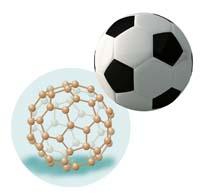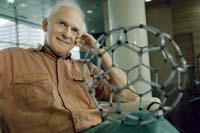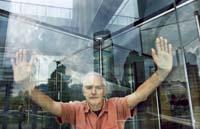"We hope to find humanitarian applications for the C60 molecule soon"

I didn't make that decision. Fullerene does not have many applications today, but it seems very useful for building solar panels. It will surely serve to replace silicon. Silicon solar panels are very expensive and fullerene C 60 is very good for generating electricity. It increases production up to five times, as it is a very effective trap for electrons. To convert the energy of the Sun into electricity it is necessary to distribute with a photon a positive charge and a negative charge. Molecule C 60 is used to trap the negative charge.
However, the main point of view of discovery is related to self-organized atoms. This was a very small and very small arrangement of atoms from bottom to top. At first we did not give it the importance it has given (and it was to give), but the structure of C 60 arises naturally. Today it is evident, but at that time it was not.
The number 60 is special. A soccer ball has 12 pentagons and the result of 5 by 12 operations is 60. It is a magic number in a configuration in the form of a football. This shape has 60 positions at the intersections of the seams. In the case of molecule C 60 there is an atom in each of these intersections. Now we understand it, it is obvious, but sometimes it is difficult to see obvious things, even for those who are quick.
It is very complicated. At that time we were making other measurements. The experiment was important to me, more important than to my peers. We were studying a carbon star, the carbon of the stars was more interesting than carbon chemistry. All carbon, including carbon that forms our body, is produced within stars. Some of these stars exploded, dispersed our carbon atoms through space and ended here on Earth. So we are lucky to be here. Our atoms could still be in space, there are still many people in space.

We did the experiment and it worked as I thought, except for a detail. A sign appeared indicating that there were sixty carbon atoms together. At first we thought it was a cluster, but then we realized it was a molecule, that is, a configuration of atoms that can be described exactly. In the search for the structure that this molecule could have, we remembered the domes made by the architect Buckminster Fuller and realized that the footprint was adequate. By then some researchers proposed that this molecule could be manufactured, but they did not suspect that it could be self-assembled. When we understood it, one day we wrote the article. It took no more than ten days to submit the article.
Some did not believe, especially some chemicals. In six articles they said we were wrong. But then others became interested. It was very interesting for theoretical chemists because they could work with this molecule. And from there it became an interesting field for this type of molecules. It took five years to prove that fullerene is a correct structure. And from 1990 everything accelerated. In addition, the discovery of fullerene led to the discovery of nanotubes. They are very interesting structures as they are good drivers.
The idea is interesting because these atoms are physically trapped inside. In the future, radioactive atoms may enter, trapped physically, rather than chemically trapped, with large differences. In this way markers could be added so that outside of fullerene it can be transferred to a certain place, where the radioactive atom can radiate, for example, in a cancer cell.
It is an idea that has not yet been developed. Next year marks the 25th anniversary of the discovery. I can hardly believe, but it is so. And still many chemicals work with the molecule. But for now we have no direct applications. In the case of the laser, they went from 25 to 30 years until they had an application. Therefore, we hope to find humanitarian applications for molecule C 60 soon.

We have already seen that it is possible, for example, to look at ourselves. If nanotechnology is a system that is built from bottom to top, atom to atom and molecule to molecule, the human being is nanotechnology, since from atom to atom and molecule the molecule has been formed. It is performed according to DNA orders, has been developed by life for millions of years. Therefore, it is clear that it can be done. But for us to do something like that, it will take a long time. It is possible but we will have to see at what speed we overcome the problems that are generated.
They have always had it; chemistry itself is nanoscience. I think people are not fully aware that chemicals work with nano-level objects. For example, the alcohol we drink is a nanoscopic molecule; also water. Therefore, chemistry is nanoscience. Perhaps the perspective has changed, because so far we have used processes of descending creation, as if from a tree we made a chair. The question now is whether we can create objects under control so that they have appropriate structures for the applications we want. Can we control the growth of a tree to create a chair? I think we can do it in the future.
I think nanotechnology XXI. It is only chemistry of the twentieth century. It is a chemistry that enters the field of condensed matter physics, and in the field of material science engineering and molecular biology. It has become a very broad field.

It is hard to say. If we were a hundred years ago, until 1909, and we met a meeting that has to make decisions about the future of chemistry, those people would know very little about it. We know it much more now. But if they were very fast, they might realize that chemistry has some dangers. There have been some serious accidents, such as dumping in the Indian city of Bhopal in December 1984, which has been a great preventable industrial accident. And it was the result of some mistakes.
If after announcing such accidents the assembly decided that they will not do chemistry, the modern world today would not exist. Many materials around us would not be, neither our clothes, nor our computers, nor many other things.
We have made mistakes, but the right ones are more than mistakes. We don't stay all for that, because if we continue to investigate, for example, the future could bring incredible medical advances.
Buletina
Bidali zure helbide elektronikoa eta jaso asteroko buletina zure sarrera-ontzian











